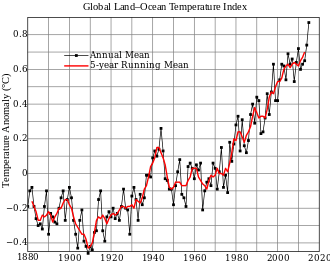Avoiding Dangerous Climate Change

Avoiding Dangerous Climate Change: A Scientific Symposium on Stabilisation of Greenhouse Gases was a 2005 international conference that examined the link between atmospheric greenhouse gas concentration, and the 2 °C (3.6 °F) ceiling on global warming thought necessary to avoid the most serious effects of global warming. Previously this had generally been accepted as being 550 ppm.
The conference took place under the United Kingdom's presidency of the G8, with the participation of around 200 'internationally renowned' scientists from 30 countries. It was chaired by Dennis Tirpak and hosted by the Hadley Centre for Climate Prediction and Research in Exeter, from 1 February to 3 February.[1]
Objectives


The conference was called to bring together the latest research into what would be necessary to achieve the objective of the 1992 United Nations Framework Convention on Climate Change:
- to achieve, in accordance with the relevant provisions of the Convention, stabilization of greenhouse gas concentrations in the atmosphere at a level that would prevent dangerous anthropogenic interference with the climate system.
It was also intended to encourage further research in the area. An initial assessment of the subject had been included in the 2001 IPCC Third Assessment Report; however, the topic had received relatively little international discussion.[2]
Specifically, the conference explored three issues:
- For different levels of climate change what are the key impacts, for different regions and sectors and for the world as a whole?
- What would such levels of climate change imply in terms of greenhouse gas stabilisation concentrations and emission pathways required to achieve such levels?
- What options are there for achieving stabilisation of greenhouse gases at different stabilisation concentrations in the atmosphere, taking into account costs and uncertainties?
Conclusions
Among the conclusions reached, the most significant was a new assessment of the link between the concentration of greenhouse gases in the atmosphere and the increase in global temperature levels. Some researchers have argued that the most serious consequences of global warming might be avoided if global average temperatures rose by no more than 2 °C (3.6 °F) above pre-industrial levels (1.4 °C above present levels). It had generally been assumed that this would occur if greenhouse gas concentrations rose above 550 ppm carbon dioxide equivalent by volume. This concentration was, for example, informing government in certain countries, including the European Union.[3]
The conference concluded that, at the level of 550 ppm, it was likely that 2 °C would be exceeded, according to the projections of more recent climate models. Stabilising greenhouse gas concentrations at 450 ppm would only result in a 50% likelihood of limiting global warming to 2 °C, and that it would be necessary to achieve stabilisation below 400 ppm to give a relatively high certainty of not exceeding 2 °C.[4]
The conference also claimed that, if action to reduce emissions is delayed by 20 years, rates of emission reduction may need to be 3 to 7 times greater to meet the same temperature target.[4]
Reaction
As a result of changing opinion on the 'safe' atmospheric concentration of greenhouse gases, to which this conference contributed, the UK government changed the target in the Climate Change Act from 60% to 80% by 2050.[5]
See also
- 4 Degrees and Beyond International Climate Conference
- Action on climate change
- Climate change mitigation scenarios
- Environmental impact of aviation
- Hypermobility (travel)
- Index of climate change articles
References
- ↑ "Climate Stabilisation Conference - Exeter 2005". Government News Network. 4 November 2004. Retrieved 15 March 2007.
- ↑ "Avoiding Dangerous Climate Change - Background". Met Office. 2005. Retrieved 16 March 2007.
- ↑ "Community Strategy on Climate Change - Council Conclusions". Council of the European Union. 22 June 1996. Retrieved 15 March 2007.
- 1 2 "International Symposium on the Stabilisation of greenhouse gas concentrations - Report of the International Scientific Steering Committee". Met Office. 10 May 2005. Retrieved 15 March 2007.
- ↑ "UK leads world with commitment to cut emissions by 80% by 2050". Department of Energy and Climate Change. 16 October 2008. Archived from the original on October 20, 2008. Retrieved 28 October 2008.
Further reading
- Related book: Avoiding Dangerous Climate Change, Editors: Hans Joachim Schellnhuber, Wolfgang Cramer, Nebojsa Nakicenovic, Tom Wigley, and Gary Yohe, Cambridge University Press, February 2006, ISBN 9780521864718 DOI: 10.2277/0521864712.
External links
- Avoiding Dangerous Climate Change - official conference website
- Tyndall Centre - A strategic assessment of scientific and behavioural perspectives on 'dangerous' climate change
- RSPB - Keeping below 2 degrees: Avoiding dangerous climate change
- WWF-UK - 2°C Is Too Much! Evidence and Implications of Dangerous Climate Change in the Arctic
- Netherlands Environmental Assessment Agency - Meeting the European Union 2°C climate target: global and regional emission implications
- Dr. James Hansen, Climate Scientist's web page
- News
- April 19, 2007, Reuters: World needs to axe greenhouse gases by 80 pct: report
- February 1, 2006, Euractive: UK chief scientific adviser: Keeping CO2 concentration below 450ppm is 'unfeasible'
- January 30, 2006, BBC: Stark warning over climate change
- January 30, 2006, BBC: Climate report: the main points
- January 29, 2006, Washington Post: Debate on Climate Shifts to Issue of Irreparable Change
- January 1, 2006, Times online: World has only 20 years to stop climate disaster
- February 4, 2005, Environment News Service: Catastrophic Climate Change Risk Accelerating, Scientists Warn
- February 3, 2005, Guardian Unlimited: Climate conference hears degree of danger